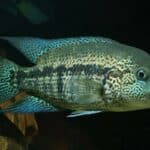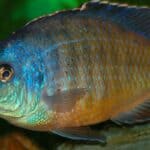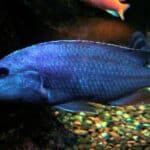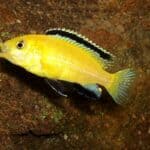The Keyhole Cichlid (Cleithracara maronii) is a small freshwater fish that is commonly found in South America, occurring in the Orinoco River basin (delta), rivers from Barima River (Guyana) to Ouanary River (French Guyana). It is popular among fish keepers because of its unique appearance and personality.
But how do you recognize a Keyhole Cichlid? The Keyhole Cichlid gets its name from the black spot on its head that looks like a keyhole. This spot is very distinct and makes the Keyhole Cichlid easy to identify. Even better, this fish has a very playful personality and often chases other fishes around the aquarium.
Unlike other cichlids, this one is not very aggressive, making it a good aquarium companion for many different species with similar characteristics.
If you want to learn more about this popular aquarium fish, this article addresses and explains all issues involving it and its maintenance requirements. Ready? Let’s begin! Content
Species Summary

Distributed over a wide area in northern South America, the Keyhole Cichlid is a species of tropical freshwater cichlid belonging to the family Cichlidae. The species occur in tea-colored, slow-flowing waters such as small to medium rivers, streams, flooded forests, and swampy areas. It is usually found near plant roots or holes and caves.
In addition, they are a great choice for an aquarium because of their excellent behavior and size. Other features that attract those who observe these species are the aggressive appearance and contrasting markings on the body, contradicting their peaceful demeanor. Cichlid species common in home aquariums worldwide have been widespread in the hobby for years and are an excellent species for beginners.
Generally speaking, the Keyhole Cichlid is a hardy, peaceful fish that can be a beautiful addition to an aquarium and is perfect for those new to fish keeping.
Keyhole Cichlid Care Guide
Keyhole Cichlids are entirely from captivity; because of this, they are considered species adapted to the water supply system. But wait, there’s more. They are also plastic species, so they easily adjust to different parameters.
Since they are peaceful, they can live in community aquariums with other fish without much trouble. Like other cichlids, Keyhole Cichlids present themselves as solitary species able to live without problems in pairs.
The Keyhole Cichlid is a lovely fish when well-cared for, even if its owner doesn’t see it swimming around the aquarium very often. Still, they will show their best colors and be seen more often when they receive a balanced diet and are in a proper aquarium.
While it is a resistant fish and is easy to care for, this does not exclude us from getting to know the species, its habits, and behaviors. Like any other species, the Keyhole Cichlid has its peculiarities which we will explore in the following topics.
Tank Size
Keyhole Cichlids are not very active fish that spend most of their time burrowed up in their caves, so they don’t require a very spacious tank. A 35″ x 11″ aquarium is more than enough for a Keyhole Cichlid, though a larger aquarium would be better if you want to keep more than one. Remember that, like most fish, the more space available, the better for their well-being.
Tank Mates
They are peaceful and non-territorial cichlids (when not breeding) that coexist without problems with other fish of different sizes in a community aquarium. They hardly feed on other fish in the aquarium; however, you should avoid keeping this cichlid with tiny fish. Likewise, avoid keeping it with big fish that are territorial and aggressive. The addition of schools of small fish seems to encourage Keyhole Cichlids to come out of their den and peacefully explore the aquarium.
They can be kept in groups as long as they are raised together from an early age to form pairs, and the aquarium is large enough for all couples to nest safely.
Now that you’ve learned that Keyhole Cichlids make a great choice for the community tank, let’s find out how they strive in a single-species tank!
Same Species Tanks
They are often used as a single species in Biotope-type aquarium setups, where the original location of the species occurs is imitated. These aquariums can be very beautiful, and can provide a great learning opportunity for fish keepers who want to see their Keyhole Cichlid in an environment that is as close to their natural habitat as possible.
Tankmates should be of similar size, have a peaceful temperament, and also share similar water preferences. Suitable fish include:
- Passive cichlid species
- Cory catfish
- Hatchetfish
- Giant danios
Avoid aggressive fish and smaller fish that can easily be eaten.
A dark water aquarium well-decorated with replica items like twisted driftwoods is an excellent Biotope-type aquarium for Keyhole Cichlids.
Water Parameters
They are highly-resistant fish, which support a wide range of parameters. This is mainly because they have been bred for years in captivity, thus gradually adapting to the water from our taps.
This cichlid can live with outstanding quality in different parameters. The perfect temperature for its maintenance is from 69 °F to 82 °F. Meanwhile, the ideal pH range is between 4.0 to 7.5 and hardness is from 36 ppm to 268 ppm.
This difference between hardness and pH is related to the origin of the specimen. Like in wild animals, it demonstrates the fluctuation of parameters during the dry and rainy seasons.
What to Put in Their Tank
When it comes to choosing what to put in their tank, many fish keepers are at a loss. While some people know exactly what fish they want to keep, others have no idea where to start. If you’re one of the latter and are interested in keeping Keyhole Cichlids, you should know a few things before getting started.
For one, Keyhole Cichlids need an aquarium heater to keep their tank healthy. Secondly, they require a lot of filtration. The filtration system must be well-dimensioned without creating a solid flow since this species inhabits waters with stopped to slow flow.
In addition to an aquarium heater and filtration system, you’ll also want to add logs, plants, and other decorations that form caves and all kinds of hiding places.
Common Diseases
They are remarkably disease-resistant fish. Your Keyhole Cichlids should not present any problem as long as you keep the water and tank’s quality in optimal conditions at all times and offer a good quality diet,
Keep in mind to always quarantine new fish before placing them in the main tank!
Food and Diet
This species, like other cichlids, is omnivorous. What does this mean? They feed mainly on benthic invertebrates and organic detritus.
In its natural environment, its primary diet is based mainly on invertebrates and detritus that live close to the river bottom. Being great eaters, these fish accept commercial rations without problems in aquariums. Dry, live, and fresh foods such as daphnia, brine shrimp, bloodworms, mosquito larvae, and others are beneficial and should be fed regularly to Keyhole Cichlids.
Therefore, providing a varied and balanced diet is essential for the species to demonstrate its full potential.
Lifespan
In an aquarium with all the correct parameters kept stable and with an ideal diet, this cichlid can live for 7 to 10 years.
But in the wild, these animals are prone to live less, as they are predisposed to diseases, attacks from other animals, and environmental causes.
Appearance
The adult Keyhole Cichlid has a robust body in the classic cichlid shape. Its body has a yellowish-brown base that appears lighter in the central region. It also has a black stripe down its eye, which crosses from the top of the head to its gill. And another thing, it has a black spot on its tail and it has a keyhole-shaped mark on its head. This mark is what gave the fish its name, ‘keyhole.’
Size
The male Keyhole Cichlid fish can easily reach 4.3 inches in length when well-cared for and fed. Females rarely exceed 2.9 inches.
Behavior and Temperament
It is a species of tropical cichlid of peaceful behavior and can be kept in a community aquarium with more minor, larger, or of the same size without problems. They are incredibly aggressive, however, when it comes to breeding or taking care of their young.
Besides, they are not very active animals. They prefer to stay hidden in a cave most of the time, only go out to feed and occupy the bottom region of the tank.
Breeding
Captive breeding for Keyhole Cichlid is an extremely simple process that is commercially done as well as in home aquariums worldwide.
The Keyhole Cichlid is a substrate spawner, which means that the eggs are deposited on the bottom of the tank and then fertilized by the male. To get viable breeding pairs, start with a group of young fish and allow them to form teams naturally, separating them as they do so. Most often, eggs are laid on solid surfaces such as rocks, pieces of logs, broad leaves of plants, or on the aquarium glass itself.
The female can lay more than 300 eggs. For this reason, stay close to them during incubation and protect them from intruders. Don’t be surprised if the male automatically safeguards- the surroundings.
Gender Differences: Male vs. Female
When it comes to the gender differences in Keyhole Cichlids, there are a few things that stand out. Males are noticeably larger than females, with more developed anal and dorsal fins.
Keyhole Cichlid Fun Facts
- Being a species inserted in the hobby for years, we hardly find wild fish that are not available. Almost all animals found for sale were bred in captivity.
- Like other cichlids, they can show their mood by darkening or lightening their color tone. For example, when they are angry or stressed, they will turn a darker color, while when they are happy or content, they will be a lighter color.
- Even though they have been adapted to captivity for years, these fish are relatively sensitive to ammonia and other free toxic nitrogens in the water.
- The etymology of its genus ‘Cleithracara’ combines the Greek kleithron, meaning lock, and acará, the Guaraní word for cichlids.
In conclusion, Keyhole Cichlids are a great choice for a beginner fishkeeper. They are hardy and easy to care for and add a lot of color to your aquarium. So if you’re thinking of getting one, go for it.
They are sure to bring you hours of enjoyment!
References
Hardman, M., L. M. Page, M. H. Sabaj, J. W. Armbruster, and J. H. Knouft, 2002 – Ichthyological Exploration of Freshwaters 13(3): 225-238. A comparison of fish surveys made in 1908 and 1998 of the Potaro, Essequibo, Demerara, and coastal river drainages of Guyana.
Kullander, S. O. and H. Nijssen, 1989 – E. J. Brill, Leiden: i-xxxii + 1-256
The Cichlids of Surinam. Teleostei: Labroidei.
Reis, R. E., S. O. Kullander, and C. J. Ferraris, Jr. (eds), 2003 – EDIPUCRS, Porto Alegre: i-xi + 1-729.








